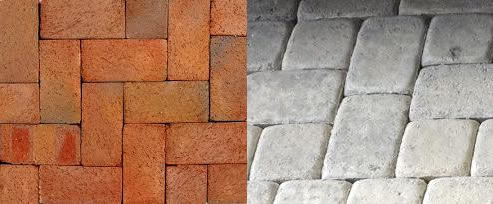Advantages of Concrete Pavers
Concrete pavers are made from cement that is poured into forms, compressed, and air cured. As a result concrete can be formed into all sorts of shapes and sizes and made in a wide range of colors which can give you a wider selection.

Concrete Bricks Are Less Expensive:
Concrete pavers are less expensive than clay brick, due to the lower cost of raw materials.
Concrete Bricks Offer More Choices:
Concrete bricks offers far more design options and colors than clay bricks. If you can imagine it, you can make it happen with concrete pavers.
Brick Design Innovation:
New and better concrete pavers are being designed all the time, so you might even find choices that correct the known downsides of concrete brick.
Advantages of Brick Pavers
The advantages of using Brick Pavers are that they are made from clay that is shaped and cured by baking in a kiln (like pottery).
Longer Color Retention:
Bricks are naturally colored by mixing in various types of clays, so they retain color better than concrete bricks, particularly when exposed to the harmful rays of the sun and weather.
Brick Pavers Tend To Last Longer:
Bricks may chip or crack over time, but they last for generations. Brick pavers tend to break in response to stress (such as ice, traffic or moisture) while the surface on concrete pavers can erode and fade over a period time.
Brick Pavers Require Less Maintenance:
Clay brick pavers resist staining and require less maintenance and cleaning than concrete pavers.
Clay Bricks Have A Timeless Style:
Clay Bricks have a distinct edge in looks and style compared to concrete bricks. An aged, worn brick walkway retains its charm while cracked or chipped concrete merely looks worn out and in need of repair.
Related Article: Differences in Pavers
